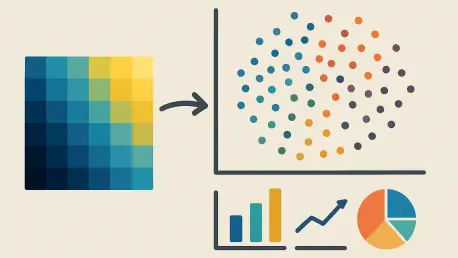In the rapidly evolving landscape of data science, managing and interpreting high-dimensional data remains a daunting challenge for researchers and developers alike, especially with datasets often containing millions of data points. The ability to visualize and explore embeddings—compact representations of complex information—has become critical to unlocking insights in AI and machine learning. Embedding Atlas, an open-source tool developed by Apple, emerges as a pioneering solution, offering local, interactive exploration of large-scale embeddings directly within a browser. This review delves into the transformative potential of this technology, examining how it addresses privacy concerns and performance demands in an era of unprecedented data growth.
Core Features and Capabilities
Harnessing WebGPU for In-Browser Power
Embedding Atlas sets itself apart by leveraging WebGPU technology to process massive datasets locally, enabling real-time interaction with embeddings on a scale previously unimaginable without server support. This approach ensures that data never leaves the user’s device, a crucial advantage for maintaining privacy in sensitive research and applications. The tool’s ability to handle millions of data points seamlessly within a browser window marks a significant leap forward in accessibility for data scientists.
Beyond privacy, the use of WebGPU allows for fluid performance, eliminating the latency associated with cloud-based processing. Users can manipulate datasets instantly, making iterative exploration a practical reality. This feature positions the tool as a go-to resource for those who prioritize both speed and data security in their workflows.
Dynamic Visualization Tools
The interactive visualization capabilities of Embedding Atlas provide an intuitive interface for uncovering hidden patterns and anomalies in embedding spaces. Features such as zooming, filtering, and searching empower users to navigate complex data with ease, while automatic clustering and labeling offer deeper insights into structural relationships. These tools simplify the often cumbersome task of interpreting high-dimensional information.
Additionally, kernel density estimation enhances the user experience by highlighting data density trends, aiding in the identification of significant clusters or outliers. The multi-coordinated metadata views further enrich analysis by linking specific features or categories to visual representations. Such functionalities make the tool invaluable for model interpretability and data exploration across diverse domains.
Seamless Integration for Diverse Users
Accessibility is another cornerstone of this technology, with dual availability as a Python package and an npm library catering to different user needs. For data scientists, the Python package integrates smoothly into workflows involving Jupyter Notebooks or Streamlit apps, facilitating command-line operations and interactive widgets. This adaptability ensures that the tool fits into established research pipelines without disruption.
For developers, the npm library offers reusable UI components, enabling the embedding of visualization engines into custom web tools or dashboards. This flexibility broadens the tool’s appeal, allowing it to serve both technical and creative purposes in building tailored data solutions. The dual-format approach underscores a commitment to reaching a wide audience in the tech community.
Technical Innovations Driving Performance
The backbone of Embedding Atlas lies in cutting-edge research from Apple, featuring scalable algorithms that optimize labeling and projection of large datasets. These algorithms ensure that even the most extensive embedding spaces can be visualized efficiently, reducing computational bottlenecks. Such innovation is critical for maintaining usability as data volumes continue to grow.
Complementing this are Rust-based clustering modules and WebAssembly implementations of UMAP, a popular technique for dimensionality reduction. These technical choices enhance the tool’s speed and efficiency, allowing it to process complex calculations directly in the browser. The result is a robust platform capable of tackling demanding tasks without sacrificing performance.
This fusion of advanced research and optimized coding reflects a forward-thinking approach to data visualization challenges. By prioritizing both scalability and local execution, the tool addresses key pain points in handling massive datasets, paving the way for broader adoption in research and industry settings.
Practical Applications Across Domains
Embedding Atlas finds relevance in a variety of real-world scenarios, particularly in areas like retrieval systems and similarity search, where understanding embedding relationships is essential. Researchers can use the tool to compare embeddings from different models or training runs, gaining insights into performance and behavior. This capability proves especially useful in refining AI algorithms.
The tool also shines in model interpretability studies, helping users visualize how data representations evolve across domains such as text or multimodal inputs. For instance, community experiments have explored transforming image data into high-dimensional vectors for concept space projection, showcasing the tool’s versatility. Such applications highlight its potential to bridge gaps between theoretical research and practical outcomes.
Beyond academic use, industries leveraging AI can adopt this technology to enhance data-driven decision-making. From improving recommendation systems to analyzing customer behavior patterns, the ability to explore embeddings locally offers a competitive edge. This wide-ranging applicability ensures that the tool resonates with diverse professional needs.
Challenges and Areas for Improvement
Despite its strengths, Embedding Atlas is not without hurdles, particularly for newcomers who may face a learning curve when navigating its extensive feature set. The interface, while intuitive for experienced users, could initially overwhelm those unfamiliar with embedding analysis. Addressing this through enhanced tutorials or onboarding resources could improve user adoption.
Hardware limitations also pose a concern, as processing extremely large datasets may strain less powerful devices, even with optimized algorithms. While the tool performs admirably on modern systems, compatibility with older hardware remains a potential barrier. Ongoing development efforts are likely needed to broaden accessibility in this regard.
Community feedback continues to play a vital role in shaping the tool’s evolution, with discussions around expanding data type support and advanced customization options gaining traction. These insights suggest a path forward for addressing current gaps, ensuring that the technology remains responsive to user demands over time.
Looking Ahead: The Future of Embedding Analysis
The trajectory of Embedding Atlas points toward exciting possibilities, with potential expansions to accommodate additional data types and more sophisticated features on the horizon. As data science evolves, the tool could incorporate enhanced analytical capabilities, further solidifying its role as a staple in research toolkits. Such growth would amplify its impact across fields.
Its emphasis on privacy and local processing also positions it as a leader in fostering trust within the AI community, encouraging collaboration without compromising data security. This focus aligns with broader trends toward ethical technology development, suggesting a lasting influence on how embedding analysis is conducted. The tool’s open-source nature only adds to its collaborative potential.
Over the coming years, from 2025 onward, wider adoption in both academia and industry could redefine standards for interactive data tools. By continuing to prioritize user needs and technological advancements, Embedding Atlas has the opportunity to inspire a new generation of privacy-focused solutions, shaping the landscape of data visualization for the better.
Final Thoughts and Next Steps
Reflecting on the journey of Embedding Atlas, its rollout marked a pivotal moment in making high-dimensional data exploration accessible and secure through local, browser-based processing. The blend of powerful visualization features, technical innovation, and integration options established it as a standout resource for data scientists and developers alike. Its impact resonated across multiple domains, from research to real-world applications.
Moving forward, stakeholders are encouraged to explore how this tool can be tailored to specific needs, whether through custom integrations or community-driven enhancements. Engaging with the open-source ecosystem to contribute feedback or develop new features offers a tangible way to address existing limitations. This collaborative spirit promises to refine the tool’s capabilities further.
Ultimately, the focus shifts to scaling its reach, ensuring that even more users can harness its potential to unlock insights from complex datasets. By investing in user education and hardware optimization, the groundwork is laid for sustained growth. Embedding Atlas stands as a testament to the power of innovative, privacy-conscious technology, ready to evolve with the demands of an ever-changing field.









